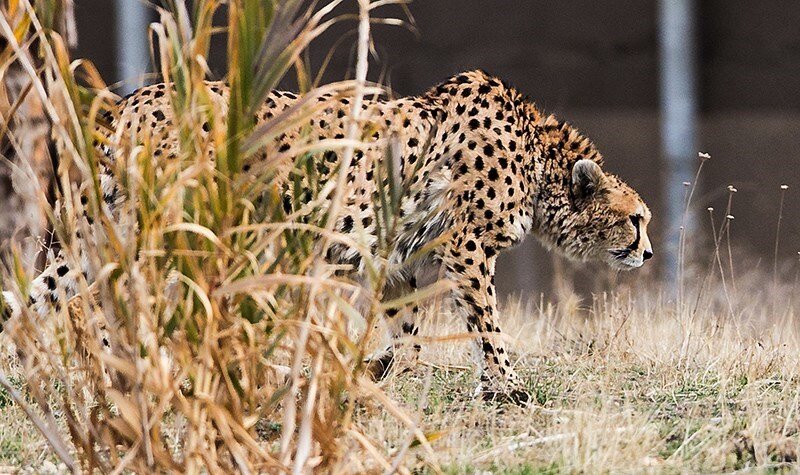Iranian cheetah in critical condition

TEHRAN – The population of Asiatic cheetahs in Iran is less than 40, which means that under the current situation and in the long run, not only is it not possible to maintain the species’ population and health but the genetic diversity will be lost and face extinction.
Fourteen years ago, the Iranian Cheetah Society (ICS) proposed August 31st as the “National Cheetah Day” in Iran to encourage the conservation of the last remaining population of Asiatic cheetahs. The National Cheetah Day is now endorsed and celebrated by the Department of the Environment (DOE), Conservation of the Asiatic Cheetah Project, and several Iranian NGOs every year.
Morteza Pourmirzaei, managing director of the Iranian Cheetah Society, emphasizes that the Department of Environment must pay attention to accurate and expert data to protect this species.
According to the latest scientific data in 2017, Iran has less than 40 cheetahs, showing that the cheetah population is shrinking. The cheetah habitat in the southern part of the country is stretching to over three million hectares, but is hosting only a few cheetahs, he noted.
“International experience has shown that when fenced in several thousand hectares, cheetahs behave normally, find and mate, and after pregnancy, females can be completely separated from males.
This method is used in South Africa and has been effective in increasing the cheetah population. In fact, this is the only way to reproduce in a semi-natural environment and then introduce the cheetah to nature,” he explained, ISNA reported on Wednesday.
Referring to the existence of 16 cheetahs in Semnan province, Pourmirzaei stated that “a species with a population of less than 100 cannot maintain its health in the long run, while with a population of less than 50, it will not be able to maintain its genetic diversity in the long run, so that, the species is in a critical condition.
At present, each individual cheetah is important, but a small increase in the number of such species, although important, alone does not make much difference in the cheetah’s extinction.”
He went on to say that the camera traps in the breeding habitats of cheetahs such as Turan and Miandasht protected areas, show that the situation is quite critical, and more measures should be taken to protect and reproduce the cheetah.
For about 10 years, there has not been any evidence of female cheetah presence in the southern habitats, which includes Yazd, Kerman, South Khorasan, and Isfahan, he lamented.
The government should consider accurate and expert data for decision making, while expert opinions were not taken into account in captive breeding, he concluded.
Captive breeding or habitat protection?
Iman Memarian, a wildlife veterinarian, said that “Whether reproduction in captivity or semi-captive conditions does not save the Asian Cheetah from extinction, because even this type of reproduction has not been successful in South Africa.
More importantly, cheetahs born in these conditions cannot return to nature.
Asiatic cheetah born in captivity will never learn the skills to survive in nature and will not be able to reproduce in nature, thus a captive breeding plan cannot be considered as a measure to prevent the extinction of the cheetahs, he lamented.
So that, protection of natural habitats can be more effective, as the species can naturally reproduce in the environment and proper condition, he stated.
Fastest mammal endangered
Over the past 60 years, Iran is home to the last known population of Asiatic cheetah, which once roamed across vast ranges of the west and south Asian countries, from the Middle East to India. Listed as critically endangered by the IUCN, the Asiatic cheetah is among the rarest cats in the world at the subspecies level, with fewer than 50 believed to remain in Iran.
Cheetahs’ habitats in Iran are stretching over 12 million hectares of land area and over the past 16 years only experts collaborating with the CACP project have strived to count 48 cheetahs using trap cameras and other technical methods, Majid Kharrazian-Moqaddam, director of aquatic wildlife and biodiversity office at the DOE, said in August 2018.
Roadkill constitutes 70 percent of cheetahs’ fatalities, as some 42 Asiatic cheetahs have been killed in the country during the past 16 years, 28 of them died in road crashes and 14 others were either killed in conflicts with guard dogs or due to other unknown reasons, he lamented.
For one Abbasabad-Mayami road, linking north-central Semnan province to Mashhad, the northeastern province of Khorasan Razavi, is one of the deadliest roads for Asiatic cheetahs as 8 cheetahs have been killed in this area over the past 10 years.
Roads fragmenting cheetahs’ habitats are the main threats for the species, while guard dogs and stray dogs, drought spells, decreasing population of the prey species to support the cheetahs, and habitat loss are also other factors endangering the sparse population of the cheetahs in the country.
FB/MG
